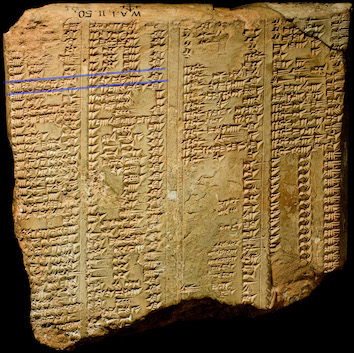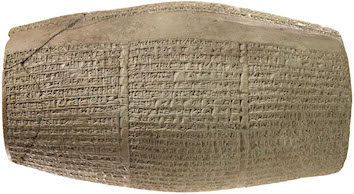Ekunankuga (ziggurat of Šamaš at Sippar)
The ziggurat of Sippar, Ekunankuga, is mentioned by name in a royal inscription of the Neo-Babylonian king Nabonidus, in the Kuyunjik Ziggurat List, and in the Neo-Babylonian Ziggurat List. The existence of a temple-tower in this important northern Babylonian city, however, is attested textually already during the First Dynasty of Babylon.

Reverse of K 02053a + K 04337, col. iv of which contains the "Kuyunjik Ziggurat List." The name of Šamaš' ziggurat at Sippar, Ekunankuga, is mentioned in col. iv 8. Image adapted from the CDLI.
Names and Spellings
The Sumerian ceremonial name of the sun-god's ziggurat at Sippar is Ekunankuga, which means "House, Pure Stairway of Heaven." It is presently attested in first-millennium BC cuneiform sources. Earlier sources (see below), however, refer to this structure as "a ziggurat, an exalted terraced-building" (Sumerian u₆-nir gi-gun₄-na-mah) and as "a ziggurat, an artificial mountain" (Sumerian u₆-nir (hur-)saŋ galam-ma), without mentioning the building's name.
- Written Forms: e₂-kun₄-an-ku₃-ga.
Known Builders
- Old Babylonian (ca. 1900–1600 BC)
- Samsu-iluna (r. 1749–1712 BC)
- Ammī-ṣaduqa (r. 1646–1626 BC)
- Neo-Babylonian (ca. 626–539 BC)
- Nabopolassar (r. 625–605 BC)
- Nebuchadnezzar II (r. 604–562 BC)
- Neriglissar (r. 559–556 BC)
- Nabonidus (r. 555–539 BC)
Building History
Although the earliest textual reference to Sippar's ziggurat dates around Year 18 of the Old Babylonian ruler Samsu-iluna (1732 BC), the seventh king of the First Dynasty of Babylon, this temple tower probably was founded much earlier, like Sippar's principal temple Ebabbar. Sumerian and Akkadian royal inscriptions of Samsu-iluna, the son and immediate successor of Ḫammu-rāpi (r. 1792–1750 BC), record that that Old Babylonian king "raised the summit of (Sippar's) ziggurat, their (Šamaš and Aya's) exalted terraced-building, as high as the heavens." Like Ebabbar, whose mud-brick structure was built anew, Samsu-iluna's work on the ziggurat was probably undertaken to renovate the building's ageing brickwork, rather than as a new foundation. Ammī-ṣaduqa, the tenth and penultimate ruler of the First Dynasty of Babylon, also made repairs to that monumental building in or after his seventeenth year as king (1630 BC), according to one of that king's year names.
Extant textual sources presently do not provide any information about the building history of Ekunankuga between the end of the First Dynasty of Babylon and the beginning of the Neo-Babylonian Empire, which was establish under Nabopolassar. Therefore, it is not possible to trace which Babylonian and Assyrian kings from the First Dynasty of the Sealand to the end of Assyrian domination of Babylonia (626 BC), sponsored work on this important religious structure at Sippar during that thousand-year span of time. In the Neo-Babylonian Period (625–539 BC), however, it is known from royal inscriptions that restoration work on Ekunankuga was sponsored by no less than four of Babylon's last six native kings.

VA 02536, a three-column clay cylinder that is inscribed with the so-called "Ehulhul Cylinder Inscription" of Nabonidus. Ekunankuga is mentioned by name in col. iii 4. © Staatliche Museen zu Berlin – Vorderasiatisches Museum. Photo: Olaf M. Teßmer.
Nabopolassar appears to have initiated repairs on Šamaš' ziggurat around the same time that he was rebuilding Edinna, the temple of the goddess Ištar as Bēlet-Sippar ("Lady of Sippar") and strengthening the embankment walls of a canal that ran between the Euphrates River and Sippar. According to later inscriptions, that temple tower's brick structure had been severely eroded and carried away by "rains and downpours" and was in desperate need of repairs. It is unclear how far the work had progressed while Nabopolassar was king, but it must not have been very far along since the later ruler Neriglissar recorded in at least one inscription that the work on Ekunankuga was unfinished when he became king in 559 BC. According to that same fragmentarily-preserved Akkadian text, an unnamed former king (who is presumably Nabopolassar's son and immediate successor Nebuchadnezzar II) "had put its (the ziggurat's) brickwork (back) in goo[d order], had reb[uilt] its collapsed section(s), had constructed (it to a height of) twenty-two cubits, but [had] not co[mplete its] superstructu[re]." Although Nebuchadnezzar himself claims to have finished renovating the sun-god's temple-tower at Sippar, it was actually Neriglissar or Nabonidus, the last native king of Babylon, who completed that massive undertaking. Although Nabonidus states that he built and completed Ekunankuga, it is highly likely that he only put the finishing touches on the project since the large-scale task of finishing that building's structure had been mostly completed by his immediate predecessors, namely Nebuchadnezzar II and Neriglissar.
Archaeological Remains
Only the remains of the lowest stage of Ekunankuga survive. The mudbrick base is approximately 40×40 m.
Further Reading
- Baker, H.D. and Jursa, M. 2011. "Sippar. A. II. Im 1. Jahrtausend," Reallexikon der Assyriologie 12/7–8, pp. 533–537.
- Frayne, D.R., Old Babylonian Period (2003–1595 BC) (Royal Inscriptions of Mesopotamia, Early Periods 4), Toronto, pp. 374–378 no. E4.3.7.3.
- Gasche, H. and Tanret, M. 2011. "Sippar. B. Archäologisch," Reallexikon der Assyriologie 12/7–8, pp. 537–547.
- George, A.R. 1993. House Most High: The Temples of Ancient Mesopotamia (Mesopotamian Civilizations 5), Winona Lake, p. 115 no. 672.
- Kalla, G. 2011. "Sippar. A. I. Im 3. und 2. Jahrtausend," Reallexikon der Assyriologie 12/7–8, pp. 528–533.
Jamie Novotny & Joshua Meynell
Jamie Novotny & Joshua Meynell, 'Ekunankuga (ziggurat of Šamaš at Sippar)', Babylonian Temples and Monumental Architecture online (BTMAo), The BTMAo Project, a sub-project of MOCCI, [http://oracc.org/btmao/Sippar/Ekunankuga/]